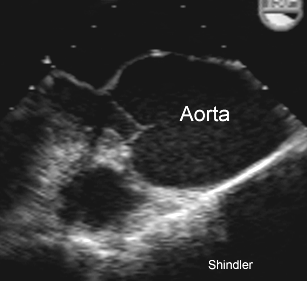 Pear shaped proximal ascending thoracic aorta in a
patient with Marfan syndrome.
Pear shaped proximal ascending thoracic aorta in a
patient with Marfan syndrome.
 Pear shaped proximal ascending thoracic aorta in a
patient with Marfan syndrome.
Pear shaped proximal ascending thoracic aorta in a
patient with Marfan syndrome.
Ital Heart J. 2003 Sep;4(9):589-95.
Aortic valve dysfunction and dilated ascending aorta. A complex and controversial association.
Cotrufo M, Agozzino L, De Feo M, Corte AD, De Santo LS, Di Benedetto G, Esposito S, Nappi G.
Department of Cardiothoracic and Respiratory Sciences, Second University of Naples, Naples, Italy. maurizio.cotrufo@unina2.it
Several pathogenetic mechanisms account for the association of the ascending aorta dilation with aortic valve dysfunction. Functional aortic insufficiency can derive from medial degeneration of the aortic wall and annuloaortic ectasia; leaflet structural disease can determine root dilation by increasing aortic wall stress in case of both regurgitation and stenosis; aortic valve disease and aortic aneurysm can however coexist due to two different intrinsic etiologies. In the attempt to best tailor the surgical correction of such conditions to the underlying causative mechanism, several technical options have already been developed including composite or separate aortic valve and root replacement, valve-sparing operations, and aortoplasty techniques. The criteria for surgical indication cannot leave the underlying pathogenesis out of consideration as well. The newly acquired knowledge in the basic research on this topic is expected to affect the approach to the individual patient in the future.
Ital Heart J. 2003 Jul;4(7):454-9.
Sixteen-year results of composite aortic root replacement for non-dissecting chronic aortic aneurysms.
Gelsomino S, Masullo G, Morocutti G, Frassani R, Da Col P, Parise O, Spedicato L, Livi U.
Department of Cardiovascular Sciences, S. Maria della Misericordia General Hospital, Udine, Italy. sandrogelsomino@virgilio.it
BACKGROUND: The aim of this study was to evaluate the early and long-term outcomes in patients undergoing a Bentall procedure or its button modification for chronic aortic aneurysms with aortic valve incompetence. METHODS: Between January 1986 and January 2002, 65 patients (84% males, mean age 58.9 +/- 11 years) underwent aortic root replacement with a Bentall or a button-Bentall operation. Annuloaortic ectasia was the most frequent cause of aortic disease in this series (n = 37, 56.9%), followed by atherosclerotic aneurysms (n = 22, 33.9%), and post-stenotic dilation (n = 5, 7.7%). One patient (1.5%) underwent redo aortic root replacement,3 (4.6%) had a Marfan syndrome, and 6 (9.2%) underwent a concomitant replacement of the aortic arch. The duration of follow-up ranged from 2 to 192 months (mean 89.6 +/- 21.8 months). RESULTS: The 30-day mortality was 0%. Early non-fatal complications comprised: bleeding requiring surgical re-exploration (n = 1, 1.5%), low output syndrome (n = 1, 1.5%), acute renal insufficiency (n = 1, 1.5%), transient ischemic attack (n = 2, 3.1%), stroke (n = 1, 1.5%), and pulmonary insufficiency (n = 1, 1.5%). There was a late death due to a pulmonary neoplasm. The 16-year actuarial survival was 97 +/- 2% (hazard 0.02 +/- 0.02). No patient required reoperation. Furthermore, the long-term clinical follow-up was characterized by the complete absence of endocarditis, anticoagulant-related hemorrhage, valve thrombosis, and prosthetic failure. Finally, the NYHA functional status was significantly improved (1.1 +/- 0.50, p < 0.001 vs preoperatively). CONCLUSIONS: The late results of the Bentall and button-Bentall procedures were excellent. Our findings confirm that these techniques still constitute the gold standard in the surgical treatment of combined valve and ascending aorta pathologies.
Ann Thorac Surg. 2003 Jan;75(1):126-31.
A long-term experience with the Cabrol root replacement technique for the management of ascending aortic aneurysms and dissections.
Gelsomino S, Frassani R, Da Col P, Morocutti G, Masullo G, Spedicato L, Livi U.
Department of Cardiovascular Sciences, Ospedale S. Maria Della Misericordia, Udine, Italy. sandrogelsomino@virgilio.it
BACKGROUND: Little information exists regarding the long-term results of the Cabrol technique. This study aimed at exploring, over a 16-year period, the results of aortic root replacements employing this procedure. METHODS: Between 1986 and 2002 forty-fiv e patients (mean age 58.7 +/- 13.8 years old, 84.4% male) underwent a Cabrol procedure. Aortic dissection was the most frequent cause of aortic disease in this series (n = 17), followed by annuloaortic ectasia (n = 10), atherosclerotic aneurysm (n = 5) an d poststenotic dilatation (n = 5). Six patients (13.4%) had undergone a previous aortic operation, 8 (17.7%) had a Marfan syndrome and five (11.1%) underwent concomitant arch replacement. Mean clinical follow-up was 87.3 +/- 24.3 months. Twenty-eight pati ents (93.3% of survivors) had a transesophageal echocardiography (TEE) performed at a mean of 64 +/- 32 months postoperatively. RESULTS: Early mortality was 20%. It was 9.1% for patients with an ascending aortic aneurysm and 41.2% for dissections (p = 0.0 26). Independent multivariate predictors of early mortality were: aortic dissection (p = 0.009), emergency operation (p < 0.001), operative year (p = 0.02), cross-clamp time (p = 0.001), and CPB duration (p < 0.001). Actuarial survival was 0.77 +/- 0.06, 0.72 +/- 0.06, 0.59 +/- 0.04 and 0.59 +/- 0.04 at 1, 5, 10, and 16 years, respectively. Multivariate analysis revealed age (p = 0.007), cross-clamp time (p = 0.0006) and CPB duration (p = 0.009) as strong predictors of poor late survival. A periprosthetic jet with significant valve regurgitation was detected by TEE in 3 patients. In one of them, an infected periprosthetic space-right ventricular fistula was demonstrated requiring reoperation. Altogether, freedom from reoperation and endocarditis at 16 yea rs was 0.97 +/- 0.02 and 0.94 +/- 0.03, respectively. CONCLUSIONS: The Cabrol technique demonstrated a nonnegligible incidence of early and long-term complications. It should be rarely used and only when a "button" technique is not feasible.
Back to E-chocardiography Home Page.

The contents and links on this page were last verified on
October 23, 2012
by Dr. Olga Shindler.